Deployment Overview
This document describes how to set up multi-factor authentication (MFA) for Cisco Meraki L2TP VPN with AuthPoint as an identity provider. Cisco Meraki must already be configured and deployed before you set up MFA with AuthPoint.
Cisco Meraki can be configured to support MFA in several modes. For this integration, we set up RADIUS with AuthPoint.
Integration Summary
The hardware and software used in this guide include:
- Cisco Meraki MX64 vMX 16.13
- AuthPoint Gateway v6.1.1 or higher
Cisco Meraki Configuration for RADIUS Authentication
AuthPoint communicates with various cloud-based services and service providers with the RADIUS protocol. This diagram shows an overview of the configuration required for RADIUS authentication.

Before You Begin
Before you begin these procedures, make sure that:
- Your Meraki device is managed by Meraki Cloud
- You have installed and configured AuthPoint Gateway (see About Gateways)
Configure the Cisco Meraki
Complete the steps in this section to configure the Cisco Meraki MX64.
- Log in to Meraki Cloud.
- From the Network drop-down list, select your Meraki device.
- Select Security & SD-WAN > Configure > Client VPN.
- From the Client VPN server drop-down list, select Enable.
- In the Subnet text box, enter a new subnet for the client VPN.
- From the DNS server drop-down list, select Specify nameservers. In some environments, you might select use umbrella.
- In theCustom nameservers text box, enter your DNS server IP address.
- In the Shared secret text box, enter shared secret to use for the L2TP/IPSEC VPN connection.
- From the Authentication drop-down list, select RADIUS.
- Click Add a RADIUS server.
- In the Host text box, enter the IP address of the AuthPoint Gateway.
- In the Port text box, enter 1812.
- In the Secret text box, enter the shared secret to use for RADIUS authentication. This secret key is used to communicate with the RADIUS server (AuthPoint Gateway).
- Click Save Changes.
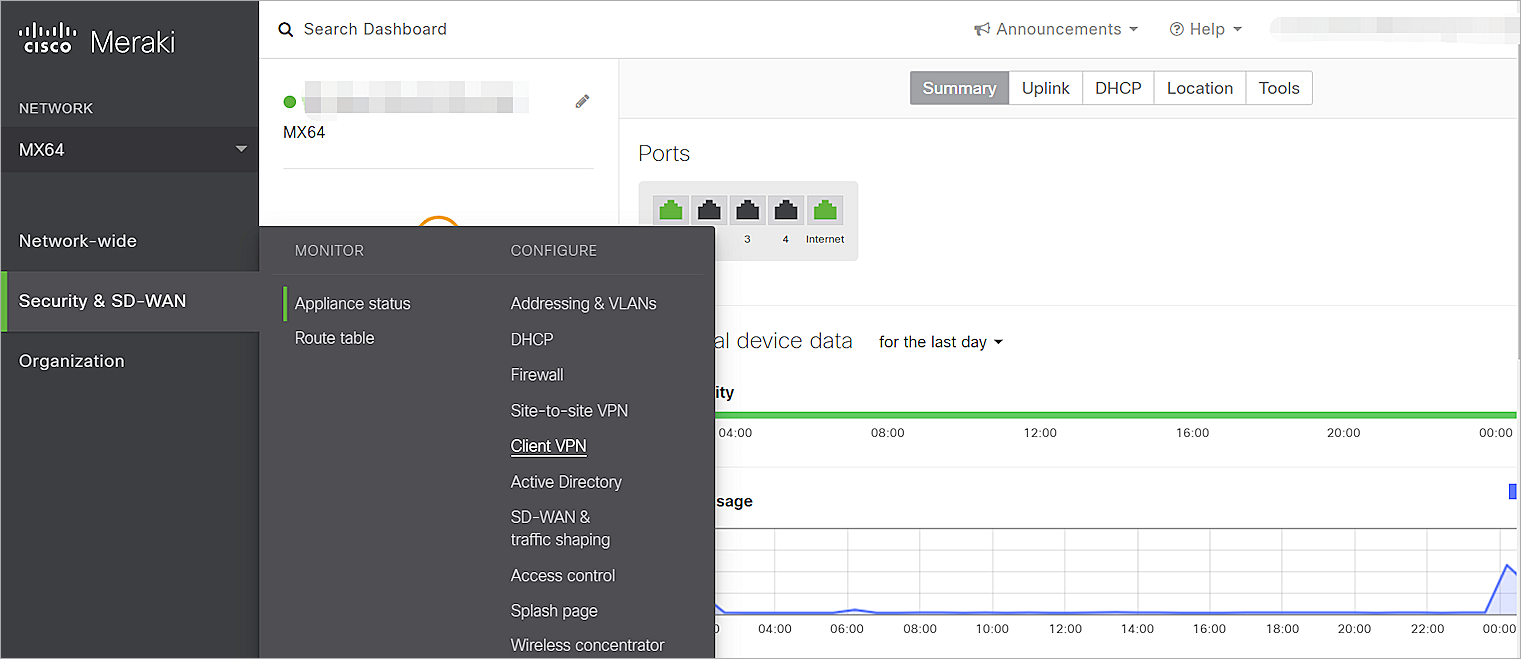
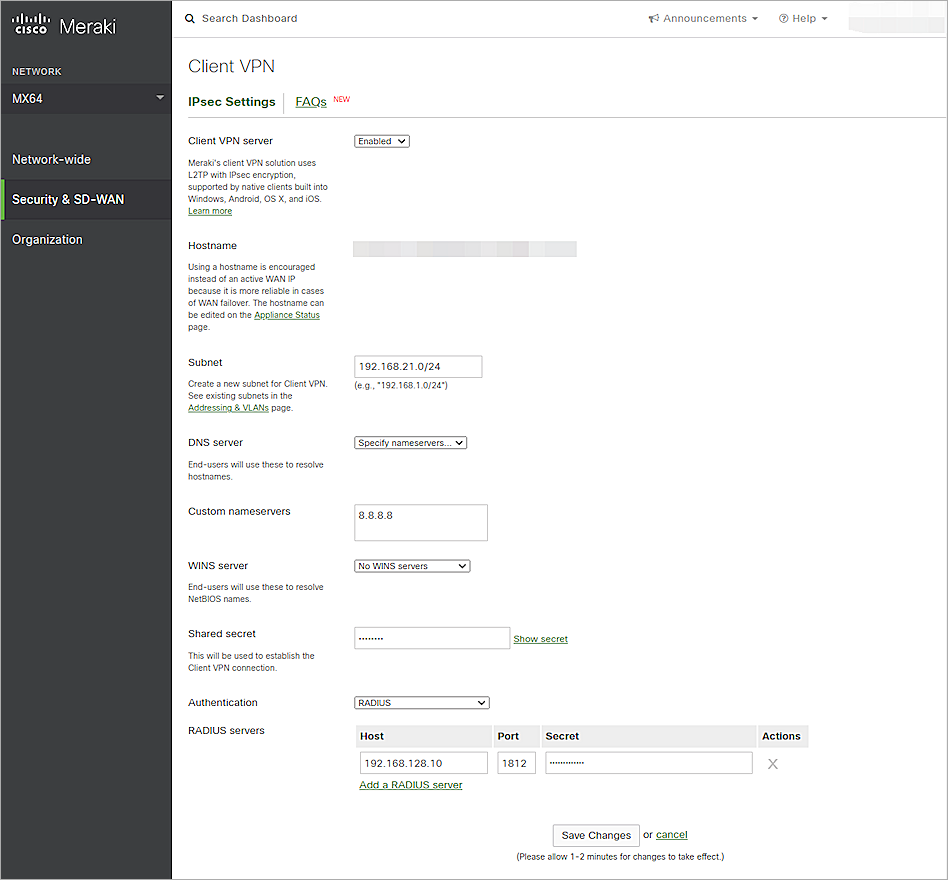
Configure AuthPoint
Before AuthPoint can receive authentication requests from your Cisco Meraki, you must:
- Specify your Cisco Meraki as a RADIUS client resource in AuthPoint.
- Add an authentication policy for the Cisco Meraki RADIUS client resource or add the Cisco Meraki RADIUS client resource to an existing authentication policy.
- Bind the Cisco Meraki RADIUS client resource to the AuthPoint Gateway.
Add a RADIUS Client Resource in AuthPoint
From the AuthPoint management UI:
- From the navigation menu, select Resources.
Click Add Resource.
The Add Resource page opens.

- From the Type drop-down list, select RADIUS Client.
Additional fields appear.

- In the Name text box, type a descriptive name for the resource.
- In the RADIUS client trusted IP or FQDN text box, enter the IP address that your RADIUS client uses to send RADIUS packets to the AuthPoint Gateway. This must be a private IP address.
- From the Value sent for RADIUS attribute 11 (Filter-Id) drop-down list, specify what is sent for the attribute 11 (Filter-ID) value in RADIUS responses. You can choose to send the user's AuthPoint group or the user's Active Directory groups.
- In the Shared Secret text box, type the shared secret key that you specified when you configured Cisco in the previous section. This is the password that the RADIUS server (AuthPoint Gateway) and the RADIUS client will use to communicate.
- Click Save.
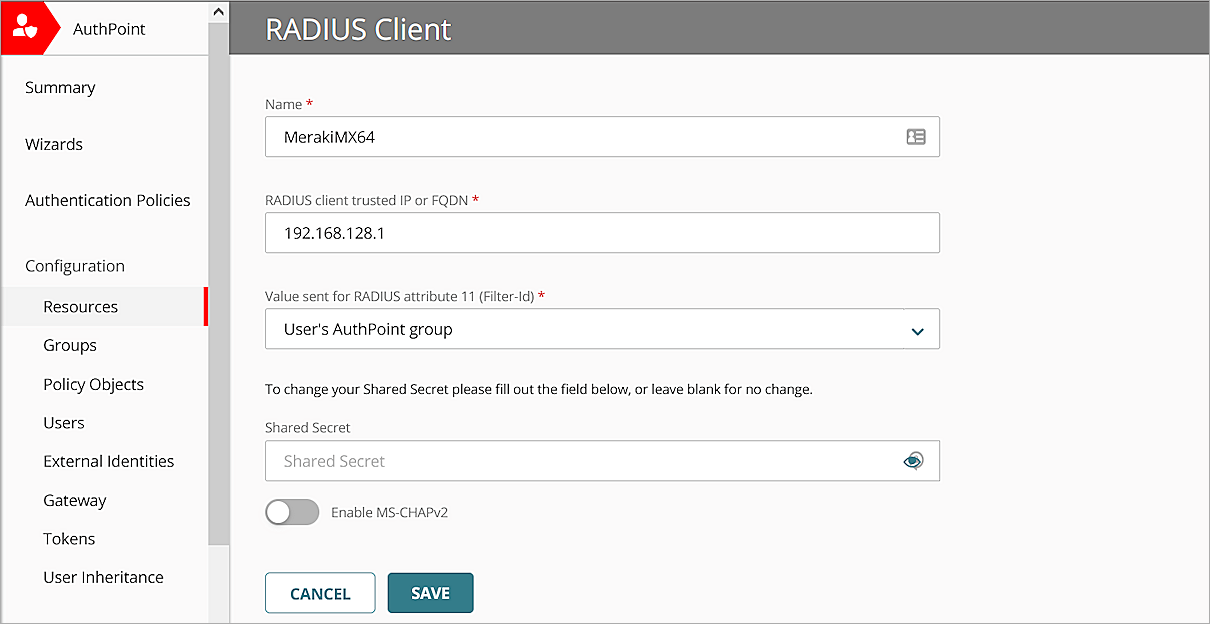
Add a Group in AuthPoint
You must have at least one user group in AuthPoint to configure MFA. If you already have a group, you do not have to add another group.
To add a WatchGuard Cloud-hosted group to the WatchGuard Cloud Directory:
- Go to Configure > Directories and Domain Services.
- Click the WatchGuard Cloud Directory domain name. If you have not yet added the WatchGuard Cloud Directory, click Add Authentication Domain and select the WatchGuard Cloud Directory.
The New Group page appears.

- In the Groups tab, click Add Group.
- In the Group Name text box, type a descriptive name for the group.
- (Optional) In the Description text box, type a description of the group.
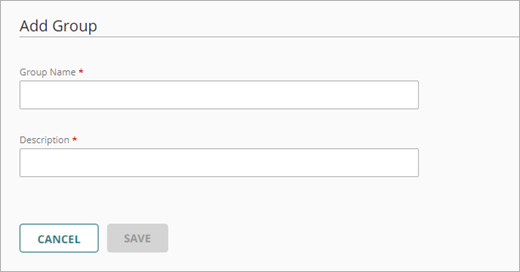
- Click Save.
Your group is added to the WatchGuard Cloud Directory and to AuthPoint.
Add an Authentication Policy to AuthPoint
Authentication policies specify which resources users can authenticate to and which authentication methods they can use (Push, QR code, and OTP).
You must have at least one authentication policy in AuthPoint that includes the Cisco Meraki resource. If you already have authentication policies, you do not have to create a new authentication policy. You can add this resource to your existing authentication policies.
Users that do not have an authentication policy for a specific resource cannot authenticate to log in to that resource.
To configure an authentication policy:
- From the navigation menu, select Authentication Policies.
The Authentication Policies page opens.

- Click Add Policy.
The Add Policy page opens.

- In the Name text box, type a name for this policy.
- From the Select the Authentication Options drop-down list, select Authentication Options, then select which authentication options users can choose from when they authenticate.
If you enable the push and OTP authentication methods for a policy, RADIUS client resources associated with that policy use push notifications to authenticate users.
QR code authentication is not supported for RADIUS client resources.
- From the Groups drop-down list, select which groups this policy applies to. You can select more than one group. To configure this policy to apply to all groups, select All Groups.
- From the Resources drop-down list, select the resource that you created in the previous section. If you want this policy to apply to additional resources, select each resource this policy applies to. To configure this policy to apply to all resources, select All Resources.

-
(Optional) If you have configured policy objects such as a Network Location, select which policy objects apply to this policy. When you add a policy object to a policy, the policy only applies to user authentications that match the conditions of the policy objects. For example, if you add a Network Location to a policy, the policy only applies to user authentications that come from that Network Location. Users who only have a policy that includes a Network Location do not get access to the resource when they authenticate outside of that Network Location (because they do not have a policy that applies, not because authentication is denied).
For RADIUS authentication, policies that have a Network Location do not apply because AuthPoint does not have the IP address of the user.
If you configure policy objects, we recommend that you create a second policy for the same groups and resources without the policy objects. The policy with the policy objects should have a higher priority.

- Click Save.
Your policy is created and added to the end of the policy list.When you create a new policy, we recommend that you review the order of your policies. AuthPoint always adds new policies to the end of the policy list.
Before you assign users to a group, you must add the users to AuthPoint. You can manually add user accounts or import user accounts from an external user database. For more information on how to add user accounts, see Add User Accounts.
Bind the RADIUS Resource to a Gateway
To use RADIUS authentication with AuthPoint, you must have the AuthPoint Gateway installed on your corporate network and you must assign your RADIUS resources to the Gateway in the AuthPoint management UI. The Gateway functions as a RADIUS server.
If you have not already configured and installed the AuthPoint Gateway, see About Gateways.
To assign your RADIUS resources to the Gateway:
- From the navigation menu, select Gateway.
- Select the Name of the Gateway.
-
From the RADIUS section, in the Port text box, type the port number used to communicate with the Gateway. The default ports are 1812 and 1645.
If you already have a RADIUS server installed that uses port 1812 or 1645, you must use a different port for the AuthPoint Gateway.
- From the Select a RADIUS Resource drop-down list, select your RADIUS client resource.
- Click Save.
Add Users to AuthPoint
Before you assign users to a group, you must add the users to AuthPoint. There are two ways to add AuthPoint user accounts:
- Sync users from an external user database
- Add WatchGuard Cloud-hosted AuthPoint users
Each user must be a member of a group. You must add at least one group before you can add users to AuthPoint.
To import users from Active Directory, Microsoft Entra ID, or an LDAP database, you must add an external identity in the AuthPoint management UI. External identities connect to user databases to get user account information and validate passwords.
- To sync users from Active Directory or an LDAP database, you must add an LDAP external identity
- To sync users from Microsoft Entra ID, you must add a Microsoft Entra ID external identity
When you sync users from an external user database, you can sync any number of users and they are all added to AuthPoint at one time. Users synced from an external user database use the password defined for their user account as their AuthPoint password.
To learn how to sync users, go to Sync Users from Active Directory or LDAP and Sync Users from Azure Active Directory.
You create WatchGuard Cloud-hosted users and groups from the WatchGuard Cloud Directory in WatchGuard Cloud. Directories and Domain Services is where you add shared authentication domains for WatchGuard Cloud devices and services, such as AuthPoint.
Users that you add to the WatchGuard Cloud Directory are automatically added to AuthPoint as well.
You add local AuthPoint users form Directories and Domain Services. You manage the users in AuthPoint on the Users page.
When you add WatchGuard Cloud-hosted AuthPoint users, you choose whether the user is an MFA user or a non-MFA user.
- MFA users are user accounts that will use AuthPoint multi-factor authentication to authenticate. This is not related to the AuthPoint Multi-Factor Authentication license type.
- Non-MFA users are users that will only ever authenticate with a password, such as a service account user. Non-MFA users do not consume an AuthPoint user license and cannot authenticate to resources that require MFA. They can only authenticate to protected resources if the non-MFA user account has a password only authentication policy for that resource.
After you add a user, you can edit the user account if you need to change their account type. When you change a user account from MFA to non-MFA, AuthPoint deletes the tokens and password vault (if applicable) that belong to the user. This action cannot be undone.
Unlike users synced from an external user database, WatchGuard Cloud-hosted AuthPoint users define and manage their own AuthPoint password. When you add a WatchGuard Cloud-hosted user account, the user receives an email that prompts them to set their password.
To learn how to add WatchGuard Cloud-hosted AuthPoint user accounts to the WatchGuard Cloud Directory, go to Add Local Users to an Authentication Domain.
Configure the L2TP VPN Client
- On your Windows 10 computer, open the Windows menu and search for VPN settings.
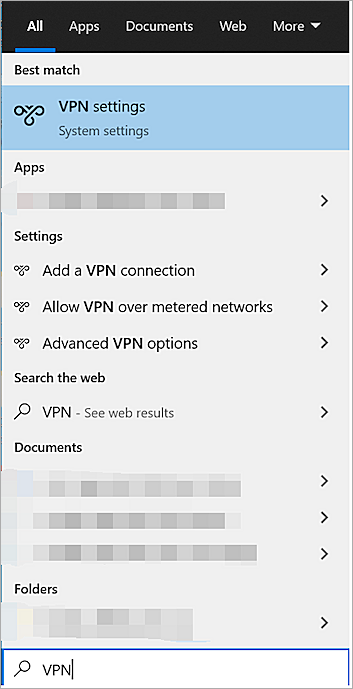
- Click Add a VPN connection.
The Add a VPN Connection window opens. - From the VPN provider drop-down list, select Windows (built-in).
- In the Connection name text box, type a name to identify this VPN connection.
- In the Server name or address text box, enter the hostname or the active WAN IP address. We recommend that you specify the hostname because it is more reliable for WAN failover. You can find the hostname or WAN IP address in Meraki Cloud if you navigate to Security appliance > Monitor > Appliance status.
- From the VPN type drop-down list, select L2TP/IPsec with pre-shared key.
- In the Pre-shared key text box, enter the pre-shared key. This must be the same pre-shared key that you configured in the previous section.
- From the Type of sign-in info drop-down list, select User name and password.
- Click Save.
The Add a VPN connection window closes.
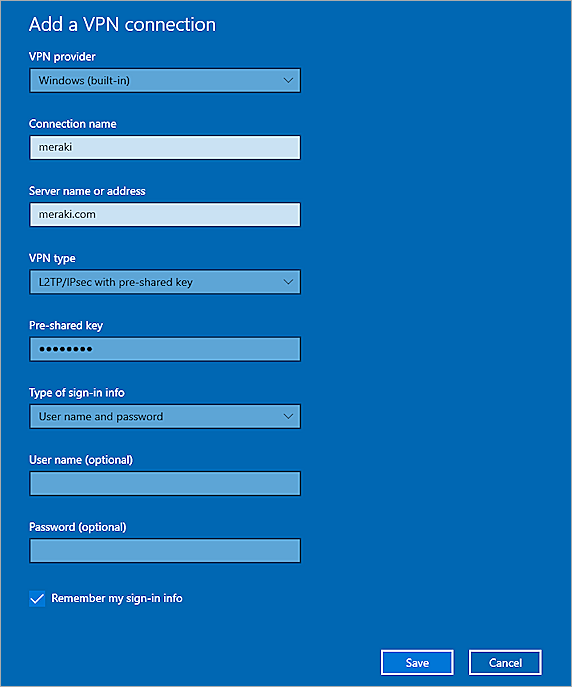
- From the Windows menu, search for Network Connections and open the Network Connections window.
- In the Network Connections window, right-click on the VPN connection that you created and select Properties.
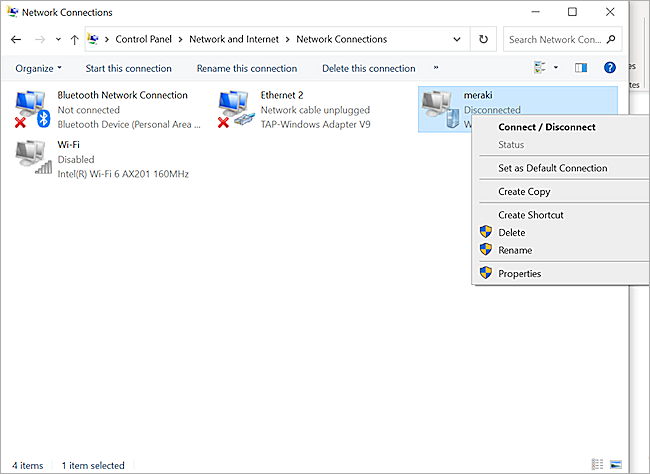
- Select the Security tab.
- From the Type of VPN drop-down list, select Layer 2 Tunneling Protocol with IPsec (L2TP/IPSec).
- From the Data encryption drop-down list, select Require encyption (disconnect if server declines).
- In the Authentication section, select Allow these protocols.
- Select the Unencrypted password (PAP)check box. Clear all other check boxes.
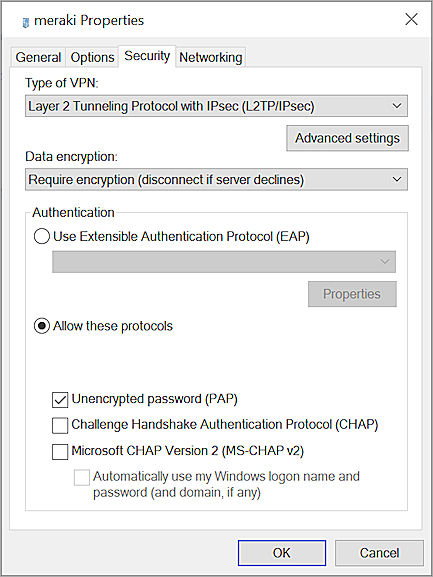
- Click Advanced settings.
- In the Advanced Properties dialogue box, select Use preshared key for authentication and enter the pre-shared key. This must be the same pre-shared key that you configured in the previous section.
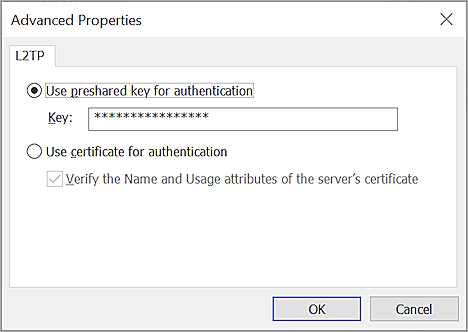
- Click OK.
- Click OK.
For more information about the L2TP VPN configuration, see the Meraki Client VPN OS Configuration documentation.
Test the Integration
To test AuthPoint MFA with Cisco Meraki, you can authenticate with a mobile token on your mobile device or a hardware token. For RADIUS resources, you can choose one-time password (OTP) or push.
In this example, we show the push authentication method (users receive a push notification in the mobile app that they must approve to authenticate).
- On your computer, select the VPN you created. Click Connect.
- Type your user name and password.
- Approve the push request that is sent to your mobile device.
The VPN connects successfully.